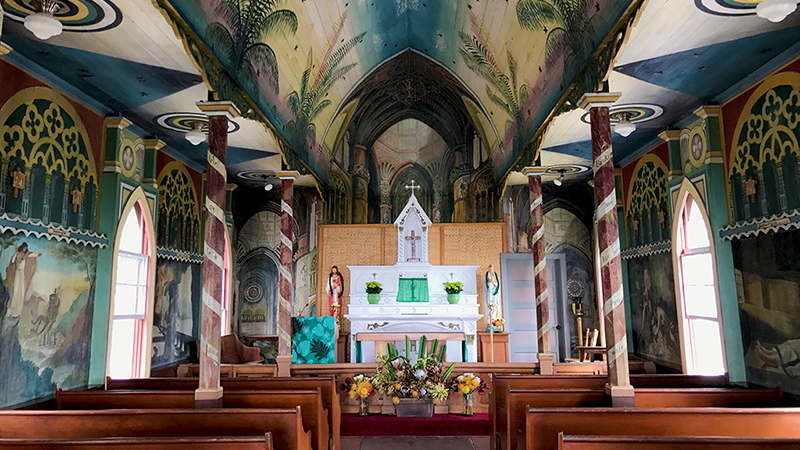
Overlooking beautiful and historic Kealakekua Bay, St. Benedict’s Painted Church is a small yet stunningly beautiful church located in the famous Kona coffee growing region, at a place called Honaunau on the Big Island of Hawaii. The church was erected in 1899 by Father John Velghe who, with no formal training, painted the interior of the church with scenes from the bible and the lives of the saints. His paintings, made from regular house paint, became important teaching tools in a time when many Hawaiians couldn’t read and write.
Known as “The Painted Church,” St. Benedict’s Church was the last stop of our day of adventuring through Kona. We visited the Hula Daddy, Mountain Thunder Organic, and Kona Joe Kona Coffee farms, we ate giant donuts at Holy Donuts, toured historic Hulihe’e Palace and Mokuaikaua Church, and explored Pu’uhonua o Hōnaunau National Historical Park.
We pulled into the St. Benedict’s Painted Church parking lot at the end of the day, tired and hungry, and not sure what to expect. Because we had already visited Mokuaikaua Church earlier in the day, we almost skipped it, and I am so glad we didn’t. The Painted Church is quite incredible, and when you take into account that all of the artistry was done with house paint by an untrained artist, it is even more remarkable. We spent time pouring over the paintings, reflecting in the cemetery, and just sitting in the church pews admiring the beauty we were surrounded with.
The History Of St. Benedict’s Painted Church
The history of St. Benedict’s Painted Church dates all the way back to when Catholicism came to South Kona in 1842, with the first church sitting on the shore of Honaunau.
By the mid 1880s however, most Hawaiians moved off the shores and up the slopes of Mauna Loa to a cooler climate with more fertile soil. When Father John Berchmans Velghe, a Sacred Hearts father from Belgium arrived in 1899, he followed the residents up the side of the volcano. The church at Honaunau was then dismantled, moved to its present location, repaired, and stood like new. In 1902, Bishop Ropert visited the new church, consecrated it, and named it in honor of St. Benedict, the father of Western monasticism.
At the time, the vault over the nave of the church was a great architectural achievement. Shaped in a cross section like a pointed arch and supported on each side by three columns, the vault covers and supports the nave. Each of the vault’s six supporting columns is octagonal, painted to resemble marble, and displaying a painted white ribbon, bearing one of the mottoes of St. Benedict’s medal.
Father Velghe, inspired by the gothic cathedral of Burgos in Spain, painted the interior of the church with scenes from the bible and the lives of the saints. His painting aided him in the teachings of Christ. The painting surrounding the altar replicate that found in the Burgos Catherdral, yet the sky and palm fronds painted on the vault over the nave give this church a distinct tropical flair and makes it unmistakably Hawaiian. Above each window is a small panel containing a cruciform rosette, supported on each side by a twisted five-fingered shape derived from the fan ribbed groins supporting the cimborio of the Burgos Cathedral.
The left and right walls of the church are each adorned with three large paintings that include:
- Eve discovers the body of her son. This is a copy of “Eve Finding the Body of Abel” by Eduard Von Gebhardt (1830-1925).
- A good death. At the upper left are heavy geometric forms which were intended to suggest a cell and the rays of light proceeding from under the grilled door.
- Hell. A lusty Satan looks toward heaven as he stretches his huge arms over his victims, a weeping, naked, tormented people.
- Appearance of the Cross to St. Francis. St. Francis is seen receiving the stigmata, the wounds of Christ.
- Temptation of Christ. To help understand the depths of God’s love for us and how Jesus truly understands our suffering and our temptations.
- Handwriting on the Wall. King Belshazzar of Babylon has refused to worship the true God, and has used the vessels from the Jerusalem Temple for a feast. This act of desecration has condemned him. The King and Queen are depicted along with the prophet Daniel, who points to the handwriting on the wall.
Father Velghe’s health deteriorated, forcing him to return to Belgium in 1904, and as he was never able to finish the painting the church, you can still see today unadorned panels, still uncompleted.
Know Before You Go
- St. Benedict’s Painted Church is located at 84-5140 Painted Church Road, Captain Cook, Hawaii 96704.
- Mass is celebrated most days at St. Benedict’s, the second Sunday of each month is the Hawaiian Mass, with readings and music in Hawaiian and a breakfast to follow.
- If you have time, stroll up the mountain to see the stations of the cross capped by a replica of Michelangelo’s Pieta.
- The church cemetery is over a century old and is still in use today.
- Much to the delight of children, you may have to step over a friendly, sleeping dog as you tour the church. You may also see the two parish cats around the grounds or rabbits scurrying under the rectory.
- St. Benedict’s Church is listed in the Hawaii State Register of Historic places and the National Register of Historic Places.
- Father John Velghe had no formal training as an artist, his canvases were made from ordinary building wood, and he used regular house paint to create the paintings.








